This piece investigates "typical autism essays" and their rhetorical commonplaces, their largely neurotypical discourse conventions. In the field of rhetoric and composition, circular metaphors in discourse community theory resemble popular representations of autism as a low-functioning/high-functioning binary. Each field-specific conversation attempts to define groups of people (student writers, autistics) as though there are hard and fast boundaries to one's identity. I posit that typical autism essays obscure issues of power as well as their neurotypically-defined genre conventions, effectively denying autistic self-advocates a place in the conversations that concern them.
I. Failure to develop peer relationships, or An introduction to typical autism essays
The typical autism essay throws around lots of numbers. There's 1 in 150 this, 1 in 4 that, 6,000% some such. The typical autism essay perseverates on the most tired of tired autism tropes, and, for once, I'm using "perseverate" negatively — aside from the numbers, there's the epidemic, the suffering parents, the bodily imprisoned auties and the socially inept and clumsily genius aspies, the celebrities with neurological ESP. Schools and practitioners are flooded (metaphorically) and families are crumbling to pieces (metaphorically) and charities are exploding (unfortunately metaphorically). According to the typical autism essay, the world's population is slowly heading the way of neurological disfigurement — because of vaccines, because of genetics, because of excessive television watching, because of airborne pollutants, because of gluten and casein and artificial sweeteners, because of, quite literally, your mom.
The typical autism essay is neurotypical: it feels the need to situate a bunch of neurotypical readers who, generally speaking, are incredibly situated in autism and its concomitant rhetorics. It is defensive. It likes numbers so much that you'd think a self-hating spectrumite penned it (if you're into the whole auties-love-numbers-duh thing, that is). I am loath to believe that readers of the typical autism essay doubt the importance of autism: it's the importance of autistics that they largely doubt. But the typical autism essay isn't about autistics — at least, it's not about autistics-as-humans inasmuch as it's about autistics-as-specimens. The typical autism essay is a sealed jar without holes poked in the lid. It's an intellectual vacuum.
Because I've been pathologized as someone who sucks at deciphering genre and discourse conventions, I'm going to run with my suckage and not do the typical-autism-essay thing. I don't need to cite Simon Baron-Cohen and lament my perpetual unempathetic state. I don't need to cite Michael Savage and lament my postulated high-functioning life of fakery and whining. I don't need to cite Suzanne Wright or James Watson and lament my very existence and waste of oxygen. I don't want their ethos and I don't need to lament.
I am not "low-functioning," I despise functioning labels, and I'm an adult woman. Three strikes against me trying to pen the typical autism essay right there — although, if I were considered "low-functioning," I suppose I'd have four strikes. I was unofficially diagnosed as a teenager and officially diagnosed as a young adult — two more ethos-damaging strikes. (I'm also not a big fan or user of transition statements — and I teach college writing, the horror! More strikes?) I know lots of spectrumites in real life and through the interwebs — verbal and nonverbal and semi-verbal and who-cares-if-I'm-verbal-I-can-still-communicate. But my voice doesn't count and my ethos doesn't register, according to the typical autism essay. In fact, my biggest strike lies in the fact that I consider myself an advocate of neurological diversity, or neurodiversity. And anything resembling neurodiversity does not jibe with the typical autism essay, because the typical autism essay is the way, the truth, and the life, according to the circumlocutious logic of the typical autism essay bible, a.k.a. Jenny McCarthy's Mother Warriors.
II. Preoccupation with parts of objects, or Circles and typical autism essays
Let me perseverate on genre theory for a moment. As an autistic rhetorician, I despise the idea of discourse communities — not so much because I have a thing against discursive utopias or social interaction as much as I have a thing against circle diagrams. According to people who like discourse communities, discourse communities look something like this:
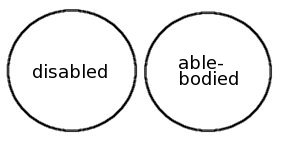
Two circles sitting side by side. One circle is labeled "disabled" and the other is labeled "able-bodied." The circles do not overlap.
Or this:
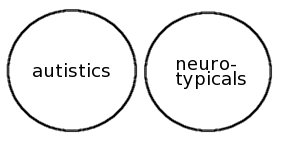
Two circles sitting side by side. One circle is labeled "autistics" and the other is labeled "neuro-typicals." The circles do not overlap.
Or this:
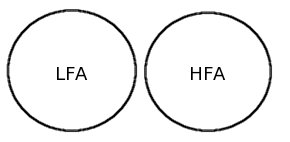
Two circles sitting side by side. One circle is labeled "LFA" and the other is labeled "HFA." The circles do not overlap.
Or this:

Three circles arranged vertically. The top circle is labeled "LFA" and slightly overlaps with the middle circle, "HFA." The "HFA" circle slightly overlaps with the bottom circle, labeled "neuro-typicality." The "LFA" and "neuro-typicality" circles do not overlap.
Or this:

Five circles, three large and two small. Like the previous diagram, three large circles are labeled "LFA," "HFA," and "neuro-typicality." "LFA" and "HFA" overlap, as do "HFA" and "neuro-typicality" — but "LFA" and "neuro-typicality" do not overlap. The two smaller circles are labeled "neuro-diversity" and "omg cure!!" and do not overlap with any other circles. The "neuro-diversity circle floats to the left and has double-edged arrows pointing toward LFA, HFA, and neuro-typicality. The "omg cure!!" circle floats off to the right and has single-edged arrows pointing toward LFA and HFA (and the arrow pointing toward LFA is rather large and thick). There are also three double-edged arrows that connect "omg cure!!" to the neuro-typicality circle.
I once wrote a 17-paged seminar paper on how much I hate circles and discourse communities, which are so totally 1980s, yet people who are so totally 1990s and 2000s still write about them and draw them and believe in their scarily mathematical existence. Patricia Bizzell, a rhetorician, wrote a foundational essay in 1982 entitled "Cognition, Convention, and Certainty," in which she argued that writing and knowledge-making are inherently social and dialogic processes. Hers was a move against the dominant paradigm at the time in the field of rhetoric and composition, a paradigm that presented writing and knowledge-making solely as individual, cognitive processes (see Flower and Hayes; Lunsford; Rose). Bizzell liked circles. Her essay was accompanied by this circle-heavy image:
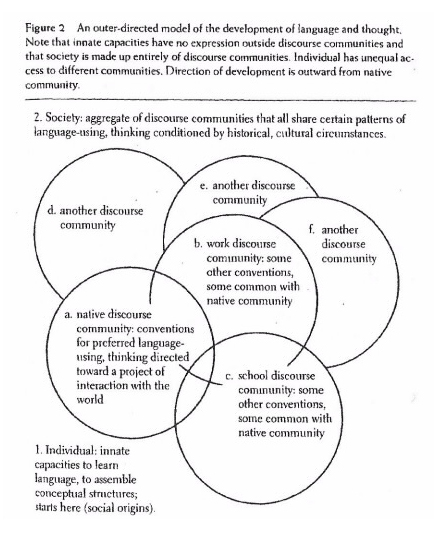
This diagram originally appeared in PRE/TEXT 3.3 (1982): 213-243. It has also been reprinted in Pre/Text: The First Decade, Ed. Victor Vitanza, University of Pittsburgh Press (1993): 65-92. Used with permission from Patricia Bizzell.
Bizzell's 1982 aim was to negate the idea that students' writing errors were the products of immature brains and/or cognitive (dys)functions, to locate some of the problems associated with entering a discourse outside of the individual mind. This move was quite necessary at the time: social epistemics attempts to de-pathologize writing and knowing and has obvious implications for studies of disability. In rhetoric and composition, the cognitive theories of the 1980s downplayed social, cultural, and ideological forces and favored the monologic over the dialectical, an omission on which social theorists such as Bizzell, Berlin, and Bartholomae were quick to capitalize. Thus, when cognitivists such as Flower and Hayes distinguished between "poor" and "skilled" student writers, argued Bizzell, they implied that " cognitive deficiency keeps poor writers from forming their own goals" [emphasis added] (379). Cognitive theories of writing focused too intently on neurological deficit and failed to explicate the manner in which outside forces shape and restrict a person's way of writing, speaking, and being — not to mention the ways in which those outside forces institute their own values and ideals.
For Bizzell, as with others who strove to de-pathologize student writing in the 1980s, discourse communities seemed the more humane, not to mention the more culturally and socially conscious, theory. Yet Bizzell continued her use of the term discourse communities in her 1999 "Hybrid Academic Discourses," as have several other scholars since (see Beaufort; Bawarshi, et. al; Richardson), despite the claims routinely made against "communities" (Gee; Harris) and their tendency to trigger binaries and oversimplicity (Rose). And, by and large, discourse community models still use circles (see Richardson's 2006 Hiphop Literacies, p. 20).
I can't be placed within an all-defining circle or even within overlapping circles, and I'm going to project (however mindblindly) that others can't contain their identities within a bounded, two-dimensional 360 degrees either, no matter how many shiny arrows radiate from the circumference. Communities aren't static, rigid, and bounded entities as the circles would have us believe. In A Teaching Subject, Joseph Harris, another scholar in rhetoric and composition, holds this position as well: communities and their circular representations are unrealistic and overly optimistic. Bizzell's 1999 theory of hybridity assumes that the solution to this stasis, this circular simplicity, is that circles can overlap and give birth to other circles — but, when it comes down to circles, this "overlap" can only account for a predefined portion of the circle. Who decides what overlaps with what, and how, and where, and when? It's also incredibly difficult to photoshop five circles in such a way that they all overlap in a sensical, accurate manner — I've tried, stereotypically aspie nerd hat on, and failed.
Of course, I'm not a math aspie, so perhaps my distaste for Venn diagram-look-alikes is cognitively biased. But when we describe autism in terms of binaries, discourse communities, or circles, we construct a very unreal, very neurotypical, very us/them reality. (And who says that only autistics reduce reality to mere black and white? Oh, that's right — the typical autism essay!) The typical autism essay, ironically, often proclaims that autism cannot be placed in a box, all the while concurrently placing autistics in boxes — LFA, HFA, mild, severe, verbal, nonverbal, etc. And, I would also posit that autism should not be (because it cannot be) contained within tidied-up circles, which, despite being round, are themselves boxlike.
Discourse community theories fail to account for how these circles get created, get named, get claimed, get dismantled. In effect, discourse communities largely render their users passive. In "Hybrid," Bizzell claims,
These elements [discourse conventions] are so powerful that the discourse could be said to take on a life of its own, independent of individual participants; it could be said, even, to "create" the participants that suit its conventions by allowing individuals no other options if they wish to be counted as participants. ("Hybrid" 9)
Per this logic, I have been passively constructed into autism — by discourse. I have been passively constructed into aspiedom — by discourse. My other autistic commonplaces — or identity markers — have also been shaped or spawned by discourses: stimdom, speechdom, lack-of-eye-contactdom, patterndom, take-everything-literally-and-then-somedom. But discourse alone can't name these things, can't claim these things. These facets of me, the diverse facets of other autistic individuals, of human individuals — autistic cousins or not — only fit within these circles because someone has squished them there, has proclaimed generalization as the new world order. Low-functioning autism exists because the people who write the typical autism essay say it does: they make the circles; the circles themselves don't independently create themselves; the circles aren't material objects that exist or breathe or birth or contain people, all neatly sorted; the circles have human help. While I like to objectify humans and categorize stuff as much as the next autie, circles alone just don't do the trick.
Genre theory draws on theories of discourse communities in a much more interesting, realistic fashion, I think, hence my perseveration — and circular digression. While genre theory (lamentably) heralds some residue of discourse community theory, it recognizes discourse users as agents. For example, Mary Jo Reiff affirms the place of human agency within discourse and declares that "real human groups" use genre, that genres serve as guides for participation within a discourse (Bawarshi et al. 553). Genre theory and its emphasis on interrelationships between human users and social systems have much to provide our understanding of typical autism essays, of typical disability essays, where "language that conveys passivity and victimization reinforces certain stereotypes…and implies that sadness and misery are the product of a disabling condition" (Linton 25). Accordingly, the typical autism essay is its own genre (a text, broadly defined, that conforms to certain "acceptable" features and styles and commonplaces and discourses and that represents and enacts social action of real human users) (Bawarshi et al.). It has its own discourse (a subset of genre, an "identity kit," a way of knowing the world and/or a culture by means of language, broadly defined) (Gee). And it has its own author(s) (real people who govern discourses and genres).
And here I digress. I should note that I don't intend for my atypical autism essay to exhaustively define and delineate the typical autism essay as a genre. As metaphorically tired and neurotypically-centric as they are, typical autism essays are nonetheless complex. As Elizabeth Wardle and other genre theorists have noted, genres themselves are highly rhetorical — and thereby highly unstable and dynamic — entities that "are context-specific and complex and cannot be easily or meaningfully mimicked outside their naturally occurring rhetorical situations and exigencies" (767-8). The typical autism essays of this decade (I hope and pray) will not be the typical autism essays of the next. But if we take any cues from genre theory as we define or denote typical autism essays, we need focus only on the ways in which genres and discourse conventions are themselves institutionalized or normalized constructs (see Couser; Medway; Wardle). Rather than merely serving as textual categories, genres "help us define and organize kinds of social actions, social actions that these texts [in this case, typical autism essays] rhetorically make possible" (Bawarshi 335). Typical autism essays are entrenched in — are rhetorical byproducts of — typical autism advocacy, activism, and action.
But back to what typical autism essays are, other than a genre that is more gag-worthy than the prospect of me retaking the GRE fifty times. As I'm here describing it, typical autism essays entail the following:
- They're about autism.
- They're typical. As in, typical autism essays are composed by those who are neurologically typical. As in, typical autism essayists assume that autistic people either cannot represent themselves or cannot represent themselves as effectively as neurotypical people can represent them. As in, typical autism essayists take most of their cues from pathology, envisioning autism as an "atypical experience of deficit and loss" (Linton 5).
- They're not limited to specific fields, though here I focus on typical autism essays within the humanities and popular media. By my own admittedly rough and highly unscientific estimation, typical autism essays account for 147 out of 150 autism-related essays — surely a generic epidemic unlike any other.
As noted above, the typical autism essay, as a genre, is non-autistic — or, at the very least, its authors claim that it is non-autistic. Completely separating neurotypicality from autism — like using the labels low-functioning and high-functioning to separate autistics — goes the route of the circles, imagining that every person is or is not one or the other, or, if one overlaps, the overlap itself is clear-cut, easily defined, easily marked with a protractor and geometric compass. I don't intend my harping on circles and typical autism essays to suggest that there aren't differences among autistics or between autistics and neurotypicals — there are. Nonetheless, relying on these two circles and their limited, two-dimensional overlaps reduces human neurology to, well, these two circles and their limited, two-dimensional overlaps. In the same manner that the typical autism essay blasts neurodiverse activists by asking, "Who's really autistic?" I would ask the converse — who's really neurotypical? What benefit is there in reducing neurology to categories countable on one's hand? And who gets to define and control the reduction? (Certainly not the circles.)
Of course, interrogating structures of power and privilege, of asking who gets to define and who gets to control, is nothing new to scholars in disability studies, indeed, to those who consider themselves scholars in anything. As James C. Wilson and Cynthia Lewiecki-Wilson describe, "Disability studies seeks to advance the cause of the disabled and promote social change by analyzing the present social formations that contribute to maintaining the walls of exclusion" (9). In the case of typical autism essays and typical autism rhetorics, the circles shore up walls of exclusion, as well as grossly simplify variations in human neurology. Lennard Davis notes, "If more effort was spent on describing the variety of human experience and less in trying to categorize into forms (literary and visual) that proscribe anomalous states of physical identity, we would be able to explore the ways that society, narrative, and politics work to oppress bodies of difference" (106). The circles' very arrangement — in all of their separateness and in all of their diametric boundedness and in all of their pity-laden overlaps — indicates just what it is that is valued and ideal. And, as Mike Rose has suggested about cognitive theories of writing and knowing, "At best, people are placed along slots on a single continuum; at worst, they are split into mutually exclusive camps — with one camp clearly having cognitive and social privilege over the other" (354).
III. Adherence to specific, nonfunctional routines and rituals, or Families wax circular poetic
In "Articles of Understanding," a joint "dialogue" between Autism Speaks and the Global and Regional Asperger Syndrome Partnership (GRASP), Michael John Carley of GRASP argues for an autism spectrum that resembles the alphabet: high- and low-functioning fail as labels, fail as circles, because such circles only account for the A and Z autistics rather than the Ls, or the Ts who were formerly Ws. In response, Alison Tepper Singer, former Senior Vice President of Autism Speaks, spits out the discourse conventions of the typical autism essay: it's easy for anyone outside of the LFA circle to denounce cure — they might have autism, but they're so far removed from, or so very only slightly overlapping with, the LFA circle that their ethos numbers range in the negatives. Writes Singer,
I'm sure a lot of thought went into the decision to include Asperger Syndrome as one of the autism spectrum disorders. On a scholarly level I understand that Asperger Syndrome is an expression of the extreme social deficits that characterize all those on the spectrum. … But the "differing abilities" of persons with Asperger Syndrome are nothing like my daughter's autism. When we at Autism Speaks use the word cure, we are most often focused on the people at the lower end of the spectrum. I have not met a person with Asperger Syndrome who seemed anything like my daughter. … It is hard to consider her "differently abled" because she is not "abled". (1)
And so the circles become:
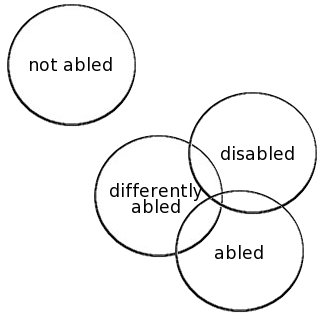
Four circles. A circle labeled "not abled" floats off in the top left corner. Three other circles, labeled "differently abled," "disabled," and "abled," overlap with one and another and sit below "not abled." These three circles do not touch the "not abled" circle.
And it is here that the circles, in all their rounded pi-ness, become even more dangerous to autistics. What Singer does, in addition to creating a whole new -abled suffix, is define low-functioning autism and low-functioning autistics wholly in terms of lack. Rhetorically speaking, she has to throw Aspergers into the mix, has to fully complete at least one binary: after all, she (wrongly) perceives that her audience is largely an audience of aspies and/or HFA auties — which is seemingly typical of GRASP as an organization. Singer, in accordance with the typical autism essay, labels neurodiversity as the cranial workings of the high-functioning — and nobody else. And, despite her supposed "audience awareness," she still decides to define Asperger syndrome in terms of deficit — rather than strengths, personality, or any "good" kind of difference — because when it comes to autism, all functioning levels are matters of deficit and lack.
To support her argument (and to reject the neurodiverse models forwarded by others on the spectrum), Singer recounts an anecdote about her non-autistic daughter's friend with Aspergers, a girl named Hayley. According to Singer, Hayley and her family suffer daily and horribly, but their suffering won't be solved with a "cure." Curing Hayley might "extinguish" her isolated aspie pockets of brilliance. In comparing Hayley to her LFA daughter, Singer writes, "She [her daughter] is sweet and loving and works harder than anyone I know, but she does not have any areas of strengths that I fear squashing through medication, intervention or cure" [emphasis added] (2).
Singer's high esteem for her autistic daughter's personhood doesn't end (or begin) there. Shortly before the GRASP/Autism Speaks dialogue was published online, Autism Speaks promoted the newly released documentary Autism Every Day at their "A New Decade for Autism" fundraiser event. Singer gained notoriety for her role in this film, which features autistic children screaming and acting violently. In a peak moment, Singer, while in the presence of her autistic daughter, claimed that she had at one point fantasized about driving her child off the George Washington Bridge, but only decided against it because of her other, neurotypical daughter. Even more horrifically, in an August 2006 segment on Good Morning America, Autism Every Day producer Lauren Thierry claimed that Singer's admission was a common feeling among autism parents: "I have heard Alison's sentiment echoed many, many times, because that is how deep the despair can go, and that is how isolated autism can make a family."

A big circle labeled "the woeful despair that is autism" floats in the top right corner and shoots three arrows at a small circle labeled "families" (which sits in the bottom left).
Before I get too carried away with lambasting Singer and every other Autism Speaks board member who has fantasized about murdering their autistic children, I should here note that Michael John Carley's A-Z representation of the spectrum in the GRASP/Autism Speaks exchange has its own typical-autism-essay residue. Carley, at first glance, diverges from Singer's medicalizations in his portrayal of the spectrum. Imagining an autism spectrum that resembles the alphabet, he suggests that the spectrum has two ends with a vast gradient in between. Yet, despite his description of potentially infinite gradation, Carley reverts to hierarchy and categories of high- and low-functioning, verbal and non-verbal, as well as mildly and "severely-challenged." Upon Carley and Singer's release of the exchange, autistic blogger and activist Amanda Baggs condemned Carley's embrace of the low/high division and created a YouTube video in protest. Similarly, blogger Autism Diva claimed that Carley's approach toward the spectrum created a dichotomy of "shiny Aspies" vs. low-functioning autistics who are "such a drag." Carley's schema, in fact, falls into the traps of cognitive categorizing that Mike Rose described in the 80s, traps that present "unexamined cultural biases about difference" (355). Though Singer medicalizes the spectrum in a fashion that Carley does not, both authors conceive of the autism spectrum as one that has a high and a low point, beginning with autism and ending with autism, beginning with ideal and ending with less than.
And thus, out of these typical representations of atypicality, new circles and new definitions arise: LF auties have nothing of value to NT society, whereas aspies can at least mimic neurotypicality sometimes. Why cure someone on the cusp of two circles? Why not try to merge all the non-NT circles into one giant NT circle? Why value neurological difference at all? How could any non-NT person not be suffering with all of those deficits and non-NT traits? And why torture innocently neurotypical families with a highly autie autistic?
As mentioned earlier, trends within the typical autism essay frequently include the purported tragedy of the NT family dealing with an autistic relative, whether high or low on the autism food chain. One organization highly reviled by neurodiverse activists, Families of Adults Affected (formerly Afflicted) by Asperger Syndrome, has based its existence on the premise that "Neuro-typical spouses have most of the answers to the questions being asked about adult Asperger's Syndrome individuals' lifestyles, behaviors." (Another typical convention of the typical autism essay — where experts on autism know more than those with autism.) Largely composed of women with aspie husbands, the organization also boasts that "…families[,] with our blistered hearts and souls and damaged psyche, are the end-product of undiagnosed and untreated Asperger's Syndrome." FAAAS has transformed ASD into a neurology that infects its relatives — literally: they claim that most NT spouses of aspies suffer from "Cassandra Affective Deprivation Disorder." In an article entitled "Please, Learn About Asperger Syndrome And Give Hope to Non-AS Spouses," author CRD open-mindedly muses, "What would I advise if I were a mental-health counselor for a couple where one spouse has AS? If it is early in the marriage and there are no children, my first instinct would be to say 'Get out now.'" Apparently, staying away from any flavor of autism is an act of self-preservation.
Certainly, family members of autistic individuals, regardless of spectrum identity, "suffer." They suffer from the looks they get at stores when their children have meltdowns; they suffer from the bruises and bites and punches they get while trying to button a coat or lace a shoe; they suffer from not understanding what their children are truly thinking or feeling; they suffer from cold stares and misunderstood cues and high debt and no insurance and overwhelmed and ignorant school districts. Family members, regardless of neurology, have a stake in the autism discussion. But, clearly, there is a problem with power dynamics in this autism discussion, because anything that doesn't suit the behavioral wants or neurological desires of the families and their charities and their researchers is somehow delegitimized, banished from typical autism essays. Those autistic individuals who do speak (literally and metaphorically) and who do speak in atypical ways are in turn constructed as not being severe enough, as being too high-functioning, as not really having autism at all, as being their own little self-contained, unique circles. Coincidentally, these non-autie autistics, despite their diagnoses or proposed fakery, still cause their parents suffering: they are, according to FAAAS and Michael Savage, respectively, inherently unempathetic individuals and "brats who … [haven't] been told to cut the act out."
This rhetoric of suffering — the sort of rhetoric that Rosemarie Garland-Thomson coins as the "rhetoric of sentimentality" — pervades the typical autism essay, using pity as collateral to defend actions that would seem unspeakable in most non-disability contexts (63). The Denver Post's December 2, 2008 article, "Autism's Terrible Toll: Parents Risk Hitting 'A Breaking Point,'" presents the sob story of Allen Grabe, a man who calmly retrieved a handgun from his closet and shot his 13-year-old autistic son, Jacob, in the head. The murder of Jacob, though handled as tragic by staff writer Nancy Lofholm, is presented as a commonplace side effect of autism, which is "debilitating" and "…can make normal family life impossible." In the typical autism essay, abusers aren't blamed for abuse — autism is, autism, which, per Lofholm, is "a maddening disorder of scrambled brain development that can lead some parents to snap, experts say." In the words of the typical autism essay, we must not only pity living and dead autistic children, but we should perhaps even shed more of our pity tears for the caretakers who transform the living into the dead; we should allot more pity for murderers than their autistic victims.
IV. Lack of emotional or social reciprocity, or Rhetoricians talk about empathy
Autism murders. Autism causes an 85% divorce rate among autism parents. Autism abuses. Autism kills emotion, and intelligence, and empathy. Autism takes otherwise normal students and forges them into arhetorical beings in need of swift NT remediation.
According to the typical autism essay, that is.
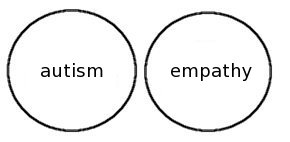
Two circles sitting side by side. One circle is labeled "autism" and the other is labeled "empathy." The circles do not overlap.
In her May 2007 College English article, "Neurodiversity," Ann Jurecic supposes that one of her students has Aspergers based on his obsessive emails, his lack of audience awareness in his writing, and his quirky personality traits. (Jurecic goes so far as to contact her student's former high school teachers to get their opinion on whether or not he is, indeed, autistic.) Jurecic's speculation leads her to believe that the main problem with autistic college students is that they lack a theory of mind: encompassed in this lack, she claims, is the inability to empathize, the inability to guess or predict what other people know. Jurecic claims that college instructors need to find balance between social and cognitive theories of writing. She suggests revisiting Linda Flower's research from the 1980s, especially her idea of "egocentric" student writers, writers who are unable to step out of their own shoes and empathize, so to speak, with their readers. Jurecic's suggestions for cognitive inquiry stand directly in contrast with Bizzell's move toward a social epistemic theory of knowledge.
What I find interesting here, as an autistic, are the ways in which "audience awareness" has become re-pathologized per Jurecic: I fear that it may be too easy for college instructors to assume that their autistic students are egocentric — solely because they are autistic. Of course, this is what the typical autism essay leads us to believe: the genre — and the authors who have painstakingly constructed this genre, a genre that is rife with painful history — has constructed autism just as neurological difference — which it is — yet fails to account for the social construction of neurological difference — which it also is — instead lumping the difference circle with that of deviance.
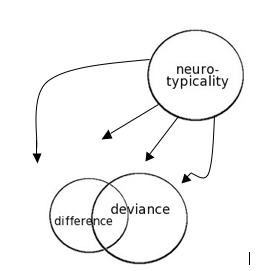
A circle labeled "neuro-typicality" floats up top and has four arrows pointing down at two other circles, one labeled "difference" and the other "deviance." The "difference" and "deviance" circles overlap, though the "deviance" circle is larger in size.
It must be noted that Jurecic's empathy theory isn't a new one — several autism specialists and medical practitioners have postulated this theory (see Simon Baron-Cohen, Alan Leslie, and Uta Frith's "Does the Autistic Child Have a Theory of Mind?"). And I should also note that, whatever frustration or disagreements I have with Jurecic's essay, her own representation of neurodiversity — a concept generally castigated or ignored in popular autism discourse — has opened much-needed discussion in my own field, for which I feel grateful (and entirely non-sarcastic). Nevertheless, Jurecic's theories bend toward medicalizations of autism and disability, medicalizations typical of the typical autism essay. Consequently, Jurecic, as a neurotypical compositionist, not only literally diagnoses writing errors but also limits her student's success to the confines of his neurology (as if neurology is the only thing that prevents him from understanding transitions or audience expectations or societal propriety). Despite her claims to the contrary, Jurecic discounts the social factors that "disable" (all) autistic individuals.
Jurecic's move toward cognitive models of disability and composing do not appear in College English without response. Jay Dolmage and Cynthia Lewiecki-Wilson critique Jurecic's reliance on an autie/NT binary: despite her mention of social models of autism, they assert, "…she remains rooted in a normate stance — from invoking a single monolithic form of the academic essay to assuming the central (invisible and normal) position that enables 'us' to diagnose others and make judgments about 'them'" [emphasis added] (314). Similarly, Paul Heilker suggests approaching disability and able-bodiedness by means of a "continuum" (319). He warns CE readers that "…the discussion seems in danger of falling into an either/or argument — either neuroscience or disability studies will ultimately be of more help in responding to the growing number of college composition students on the autism spectrum" (319). Jurecic's embrace of discourse conventions that are typical to the typical autism essay revolves around binaries and falsely circular discourse communities.
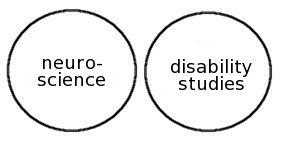
Two circles sitting side by side. One circle is labeled "neuro-science" and the other is labeled "disability studies." The circles do not overlap.
The typical autism essay guesses. A lot. Lately, a well-meaning former professor has been forwarding me columns and comments about autism spectrum disorders that have appeared in the Chronicle of Higher Education. One common CHE motif is the "I think my colleague and/or student has ASD" commentary: professors, as with Jurecic, have taken on the role of diagnostician, guessing that someone is autistic because he's a jerk, or because he sends a lot of emails, or because he doesn't like to change the copier toner since it breaks his routine, or because he quite literally lives in his office in lieu of an apartment (Brottman; "Eccentric Academics"). (And to think — all this time I've believed that the DSM IV was the diagnostic authority on ASD.) The Inside Higher Ed piece "My Semester With an Asperger Syndrome Student" also follows a guesswork motif, similar to the CHE advice columns and Jurecic's diagnosis, and it recounts a postulated aspie's behavior week by week. Like those who seek to remove autism diagnoses from the so-called aspies and HF auties, these professors and employers and colleagues use the autism label as a label of power, however unconsciously and well-intentioned. So enwrapped in autism discourse are they that they name and claim (or refuse) autism for others — something, anything, to legitimize their agendas or their pedagogy or their suffering or their copiers.
V. Delay in, or total lack of, the development of spoken language, or Typical autism essayists prevent autistic self-representation
Who can speak/write in the typical autism essay? This is the question I keep returning to — the question of who can ethically represent whom; of who does represent whom, regardless of ethics; of speaking for vs. speaking with (Osteen 7).
Frequently, when I suggest that autism doesn't need a cure — or that many autistics don't want a cure — I'm greeted with the following retort: "You shouldn't be cured. You're high-functioning."
Ah, yes. I'm a "high-functioning" autistic. As a result, unless I conform to the generic expectations of the typical autism essay, I don't count.
As I've mentioned, this high-functioning/low-functioning binary is a medical construct, and, as such, both sides of the binary are frequently used to suit the purposes of people who aren't autistic. As Phil Schwarz notes about negative representations of individuals on the spectrum, "So much of our definition as an autism community is generated by parents, professionals, clinicians, and researchers who are not autistic themselves but who hold all the cards when it comes to resources, media access, and public mindshare, that many of us are not even aware of its pervasiveness" (264). Typical constructions of autism, including "functioning" levels, are more pervasive than any so-called pervasive developmental disorder. Moreover, such definitions are themselves fraught and unstable, definitions that use neurotypicality, itself an undefined construct, as its base. We don't have a stable definition of what functioning is because of this normalized (not to mention unregulated) constructedness: if one is able to speak, is she high-functioning? If one is able to attend college, is she high-functioning? If one is able to make eye contact, is she high-functioning? If one can speak but can't work, can cook but can't drive, can read existential philosophy but can't add single digits, can hug on demand but can't stop a head-banging binge, can mimic small-talk but can't modulate the volume of her voice, can pass in short bursts but can't refrain from hand-flapping, is she high-functioning?
I've been told that I not only seem to have high-functioning autism, but high-functioning high-functioning autism, as if my new aim should be for threesies — high-functioning high-functioning high-functioning autism. How wonderfully echolalic. (If I say this three times out loud, do I have to move back two steps?)
How to react when someone ventures with, "Wow! You're smart for a person with autism"? How to avoid the circles, with all of their neurotypically defined overlaps and mutual exclusions? Why all this compare and contrast? Why one extreme or the other? Why shove diverse individuals into either/or categories?
The Autistic Bitch from Hell wrote about the problems of the HFA/LFA divide in a 2006 blog entry. She suggested that if we take any other marginalized group and insert "high-functioning" as an adjective, wars ensue. The examples she presents are as follows:
"She is a high functioning woman; unlike most women, she can live independently."
"He is high functioning for a black man; he can keep a job."
Per the typical autism essay, functioning level involves the extent to which an autistic's personality traits match up with the expectations of the particular neurotypicals who author the dominant narrative. When others denote me as a high-functioning autistic, there's still an assumption that I'm malfunctioning, because no matter how "high" I am on the grid, I'm never just plain functioning. And when autistics are coined as low-functioning, the assumptions made involve malfunctioning on warp overdrive. If we're ever going to remove autism from the funk of puzzlehood, then we need to stop with these malfunctioning robot allusions. It's as though we're labeling some autistics as gaming PCs with a few missing processor chips, and we're labeling other autistics as ribbonless, keyless, cordless typewriters circa 1883. HFA and LFA are attempts to technologize autism — and not positively, either. This machine metaphor is horrid and inaccurate, and it perpetuates division upon division, stereotype upon stereotype.
This binary brings me to an autistics.org article, "Who Can Call Themselves Autistic?" Here, the authors respond to Thomas McKean's 2006 "A Danger in Speaking." McKean writes of the autism conference circuit, denouncing speakers who have self-diagnosed as autistic and also casting suspicion on those who were officially diagnosed in adulthood. McKean reasons that the self-diagnosed and the adult-diagnosed have little to no place in the conversations surrounding autism. Although McKean poses some valid concerns about self-diagnosis (after all, we don't want autism to become a teenage internet fad), what he doesn't acknowledge are the obstacles certain autistics face in obtaining diagnostic testing. Those who are "high-functioning" adults have typically been misdiagnosed with disorders that never fit, or have been institutionalized or wrongly medicated because the "autism" of 1993 wasn't the "autism" of 1994. Moreover, insurance companies rarely cover autism-related expenses, and testing cost alone can be an expensive inhibitor. Additionally, both age and gender complicate autism diagnosis: adults learn to compensate for their autistic "oddities," and women often present as "milder" cases (Attwood, 1-8; Carley, Asperger's from the Inside Out, 48-9; Miller). Finally, McKean assumes that all autistics want to be diagnosed — as if diagnosis won't confer stigma upon an autistic individual. In short, McKean claims that self- and adult-diagnosed autistics haven't "suffered" like he has, yet he ignores the fact that these autistics have "suffered" in ways that he hasn't.
McKean's logic, as described by the autistic authors at autistics.org, is this: if you don't want a cure for autism, then you need to prove that you're autistic, because it's 99% certain that you're not really, truly autistic. Questioning someone's diagnosis is part-and-parcel of the HFA/LFA binary. These designations fail to account for the spectrum that is autism, a non-linear spectrum, at that. And, of course, if we truly want to dismantle this "functionalization" of autistics, what do we say to those autistics who do the opposite, the ones who claim that autistics who want cures or hate autism aren't "real" autistics? Writes McKean, "What you do not have a right to do is to claim that a cure is wrong for everyone. Until you have met everyone with autism in the world, until you have gotten to know them, you simply cannot make a blanket statement like this." What somewhat complicates McKean's stance — though very different from my own neurodiverse perspective — is his place on the spectrum. He certainly echoes a traditional autism narrative, yet my response to his claim, which is always evolving, causes me to wonder if it's actually cure that he is after — and whether or not he has, as Phil Schwarz describes of other pro-cure autistics, internalized the negative rhetorics that are typical of typical autism essays (264). When autistics reference cure, do they desire to become entirely new people, the sort of brain-transplant cure that neurodiverse activists decry? Or, do they mean societal acceptance, or accommodations, or diminishment of one "symptom" such as sensory overload, or equitable and accessible educational services, or medical treatment of co-morbid disorders — supports and services that contribute to quality of life, but do not truly cure, do not truly eradicate one's neurological configuration? Because if autism truly is what modern science describes it to be — genetic, neurological, and brain-based — then, indeed, a cure for autism would involve major brain rewiring or prenatal prevention — a neurologically typical power play, an elimination of one side of the circular binary.
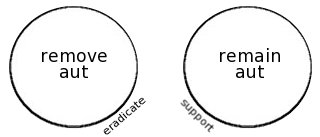
Two circles sitting side by side. One circle is labeled "remove aut" and the other is labeled "remain aut." The circles do not overlap. The word "eradicate" appears below the "remove aut circle," and the word "support" appears below the "remain aut" circle.
VI. Clinically significant disturbance, or Circling to a conclusion
And here I conclude by returning to genre theory, discourse communities, and why I hate circles — the irony of my own essayistic circling not entirely lost on my autistic mind. While discourse community theory embraces social construction — the idea that outside forces contribute to one's manner of thinking and knowing — it nonetheless reduces and restricts social forces to grossly simplified, and often binarized, categories. Like earlier cognitive theories, such circling renders real human groups passive — and autists become captives of geometric shapes and other foul representations. The circles, rather than autistics themselves, define what autism is and means.
In response to such flagrant categorization, Mike Rose warned writing instructors in 1988 of the limits of cognitive studies as applied to students' thinking and writing styles. Dichotomizing cognitive styles (e.g., between left and right hemisphere, between visual and spatial), he contended, often results in theories of hierarchy rather than theories of difference. Wrote Rose,
We must be vigilant that the systems of intellect we develop or adapt do not ground our students' difficulties in sweeping, essentially one-dimensional perceptual, neurophysiological, psychological, or linguistic processes, systems that drive broad cognitive wedges between those who do well in our schools and those who don't. (357)
Though typical autism essays do not always concern students — indeed, many wail that autists are beings incapable of being students — the message is clear: typical autism essays are stereotypically typical, and badly so. Generalization, that tired neurotypical trope, reigns: autistic people are so indistinguishable that they can all fit in one category. And if they can't fit in that category, or fill up just one circle, then they're not really, truly autistic.

A triangle labeled "a very rhetorical triangle" has punctured and deflated a melted-looking circle labeled "circle." There is also a flattened circle labeled "circle residue."
The author would like to thank Brenda Brueggemann, Lorelei Blackburn, and the special issue editors for their insightful responses to this essay.
Works Cited
- Attwood, Tony. "The Pattern of Abilities and Development of Girls with Asperger's Syndrome." Autism and Girls. Eds. Tony Attwood, Teresa Bolick, Catherine Faherty, Lisa Iland, Jennifer McIlwee Myers, Ruth Snyder, and Mary Wroble. Arlington, TX: Future Horizons, 2006. 1-8.
- Autism Diva. "Autism Speaks and GRASP: Speak without Understanding." 29 Oct. 2006. <http://autismdiva.blogspot.com/2006/10/autism-speaks-and-grasp-speak-without.html>.
- Autism Every Day. Dir. Lauren Thierry and Eric Solomon. Perf. Alison Singer. October Group, 2006. <http://www.autismspeaks.org/sponsoredevents/autism_every_day.php>.
- Autistic Bitch from Hell. "High Functioning Is an Insult, Too." Whose Planet Is It Anyway? <http://autisticbfh.blogspot.com>.
- Baggs, Amanda. "Reply to Autism Speaks and GRASP Articles of Understanding." YouTube. 28 Oct. 2006. <http://www.youtube.com/watch?v=ZhnsEJRJgeA>.
- Baggs, Amanda, Phil Schwarz, Joel Smith, and Laura Tisoncik. "Who Can Call Themselves Autistic?" Autistics.org: The Real Voice of Autism. <http://www.autistics.org>.
- Bartholomae, David. "Inventing the University." The St. Martin's Guide to Teaching Writing. Eds. Cheryl Glenn, Melissa A. Goldthwaite, and Robert Connors. Boston: Bedford/St. Martin's, 2003. 403-417.
- Bawarshi, Anis. "The Genre Function." College English 62.3 (2000): 335-60.
- Beaufort, Anne. College Writing and Beyond. Logan, Utah: Utah State UP, 2007.
- Berlin, James A. "Rhetoric and Ideology in the Writing Class." College English 50.5 (1988): 477-94.
- Bizzell, Patricia. "Cognition, Convention, and Certainty." Cross-Talk in Comp Studies. Ed. Victor Villanueva. Urbana: NCTE, 1997.
- ---. "Hybrid Academic Discourses: What, Why, How." Composition Studies 27 (1999): 7-21.
- Brottman, Mikita. "Nutty Professors." Observer — The Chronicle Review. The Chronicle of Higher Education. 16 Sept. 2005. <http://chronicle.com>.
- Carley, Michael J. "Articles of Understanding: GRASP, and the Word 'Cure.'" GRASP — Articles of Understanding. <http://grasp.org>.
- ---. Asperger's from the Inside Out: A Supportive and Practical Guide for Anyone with Asperger's Syndrome. New York: Perigee, 2008.
- Couser, G.Thomas. "Signifying Bodies: Life Writing and Disability Studies." Eds. Sharon L. Snyder, Brenda Jo Brueggemann, and Rosemarie Garland-Thomson. Disability Studies: Enabling the Humanities. New York: Modern Language Association, 2002. 109-17.
- CRH. "Please, Learn About Asperger Syndrome And Give Hope to Non-AS Spouses." Families of Adults Affected by Asperger's Syndrome. <http://faaas.org>.
- Davis, Lennard. "Bodies of Difference: Politics, Disability, and Representation." Disability Studies: Enabling the Humanities. Eds. Sharon L. Snyder, Brenda Jo Brueggemann, and Rosemarie Garland-Thomson. New York: MLA, 2002. 100-6.
- Devitt, Amy J., Anis Bawarshi, and Mary Jo Reiff. "Materiality and Genre in the Study of Discourse Communities." College English 65.5 (2003): 541-558. JSTOR. Ohio State U Lib., Columbus. 22 Nov. 2007 <http://www.jstor.org>.
- "Documenting Truth about Autism: Honest Confessions from Parents Raising Autistic Children." Good Morning America. ABC. 8 Aug. 2006. <http://abcnews.go.com/Video/playerIndex?id=2286327>.
- Dolmage, Jay, and Cynthia Lewiecki-Wilson; Paul Heilker; Ann Jurecic. "Comment and Response: Two Comments on 'Neurodiversity.'" College English 70.3 (2008): 314-325. JSTOR. Ohio State U Lib. Columbus. 25 Sept. 2008 <http://www.jstor.org>.
- "Eccentric Academics." Ms. Mentor — Chronicle Careers. The Chronicle of Higher Education. 8 May 2006. <http://chronicle.com/jobs/news/2006/05/2006050801c.htm>.
- Families of Adults Affected by Asperger's Syndrome. <http://faaas.org>.
- Flower, Linda and John Hayes. "A Cognitive Process Theory of Writing." Cross-Talk in Comp Theory: A Reader. Ed. Victor Villanueva. Urbana, IL: NCTE, 1997. 273-297.
- Garland-Thomson, Rosemarie. "The Politics of Staring: Visual Rhetorics of Disability in Popular Photography." Eds. S.L. Snyder, B.J. Brueggemann, and R. Garland-Thomson. Disability Studies: Enabling the Humanities. New York: Modern Language Association, 2002. 56-75.
- Gee, James Paul. "What Is Literacy?" Rewriting Literacy: Culture and the Discourse of the Other. Eds. Candace Mitchell and Kathleen Weiler. New York: Begin & Garvey, 1992. 3-11.
- Harris, Joseph. A Teaching Subject: Composition Since 1966. Upper Saddle River, NJ: Prentice Hall, 1997.
- Jurecic, Ann. "Neurodiversity." College English 69.5 (2007): 421-442. JSTOR. Ohio State U Lib., Columbus. 26 Sept. 2008 <http://www.jstor.org>.
- Linton, Simi. Claiming Disability: Knowledge and Identity. New York: New York UP, 1998.
- Lofholm, Nancy. "Autism's Terrible Toll: Parents Risk Hitting 'A Breaking Point.'" Denver Post. 2 Dec. 2008. <http://denverpost.com>.
- Lunsford, Andrea A. "Cognitive Development and the Basic Writer." Cross-Talk in Comp Studies. Ed. Victor Villanueva. Urbana: NCTE, 1997. 277-88.
- McKean, Thomas A. "A Danger in Speaking." <http://www.thomasamckean.com>.
- Medway, Peter. "Fuzzy Genres and Community Identities: The Case of Architecture Students' Sketchbooks." The Rhetoric and Ideology of Genre: Strategies for Stability and Change. Eds. Richard Coe, Lorelei Lingard, and Tatiana Teslenko. Cresskill, NJ: Hampton P, 2002. 123-54.
- Miller, Jean Kearns. "Introduction." Women from Another Planet? Bloomington, IN: 1stbooks, 2003. xvii-xxiii.
- "'New Decade' Fundraiser Brings in over $2M." Autism Speaks. 2006. <http://www.autismspeaks.org/sponsoredevents/new_decade_for_autism.php>.
- Osteen, Mark, ed. Autism and Representation. New York: Routledge, 2008.
- ---. "Introduction." Osteen 1-47.
- Richardson, Elaine. Hiphop Literacies. New York: Routledge, 2006.
- Rose, Mike. "Narrowing the Mind and Page: Remedial Writers and Cognitive Reductionism." Cross-Talk in Comp Studies. Ed. Victor Villanueva. Urbana: NCTE, 1997. 323-63.
- "Savage on autism: 'A Fraud, a Racket…. In 99 Percent of the Cases, It's a Brat Who Hasn't Been Told to Cut the Act Out." Media Matters for America. <http://mediamatters.org/research/200807170005>.
- Schwarz, Phil. "Film as a Vehicle for Raising Consciousness among Autistic Peers." Osteen 256-270.
- Singer, Alison T. "Cure Is Not a Four-Letter Word." GRASP — Articles of Understanding. <http://grasp.org>.
- Wardle, Elizabeth. "'Mutt Genres' and the Goal of FYC: Can We Help Students Write the Genres of the University?" College Composition and Communication 60.4 (2009): 765-89.
- Wilson, James C. and Cynthia Lewiecki-Wilson. "Disability, Rhetoric, and the Body." Embodied Rhetorics: Disability in Language and Culture. Carbondale: Southern Illinois UP, 2001.
- Yoder, Stephen A. "My Semester With an Asperger Syndrome Student." Inside Higher Ed. July 7, 2008. <http://www.insidehighered.com/views/2008/07/07/yoder>.

